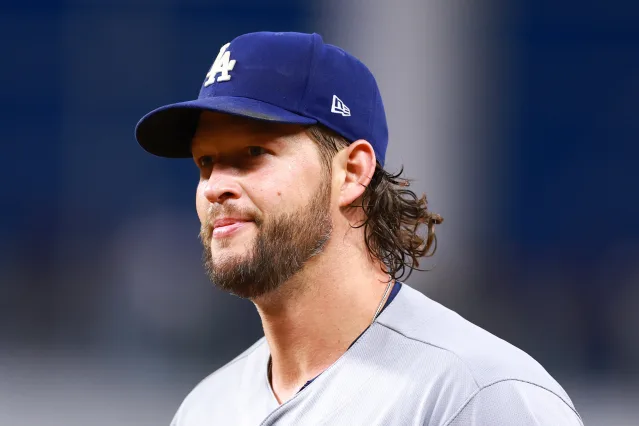Clayton Kershaw’s Return Is More Than a Comeback—It’s a Mission to Rewrite a Stigmatized Legacy That’s Always Been Misunderstood
For years, the name Clayton Kershaw has echoed across baseball diamonds as one of the most dominant pitchers of his generation. Three Cy Young Awards. Over 2,900 career strikeouts. An MVP title. The lowest career ERA among starters in the modern era (minimum 1,500 innings). His resume reads like a Hall of Fame induction speech waiting to happen. And yet, for all his greatness, Kershaw has carried a burden—an unfair, persistent label that refuses to fade: postseason choker.
The word? Stigmatized.
It’s defined by being unfairly blamed, your lowest moments amplified while your greatest ones are ignored or conveniently forgotten. That’s been Kershaw’s reality. Even some within the Dodger faithful have bought into the narrative, letting heartbreak overshadow the brilliance they’ve witnessed for over a decade.
But here’s the thing about stigmas—they thrive on selective memory. And Kershaw’s postseason story is far more complex, far more heroic, than the surface-level barbs suggest.
The upcoming chapter? His return to the mound this season isn’t just about innings, strikeouts, or statistics—it’s about redemption. It’s about setting fire to the falsehoods and reminding the baseball world exactly who Clayton Kershaw is when the lights burn brightest.
Let’s talk facts.
Go beyond the memes, the recited failures, the convenient clips played on loop every October. Look closer:
2020 World Series Game 1 — Kershaw took the ball with pressure at an all-time high. The Dodgers, still reeling from previous postseason disappointments, needed a tone-setter. Kershaw delivered: six innings, two hits, one earned run, eight strikeouts. Dominance. Stability. The beginning of a championship run.
2020 NLCS Game 2 — Same postseason. Six innings, one earned run. The Dodgers were down in the series, their backs creeping toward the wall. Kershaw steadied the ship. The offense followed.
2016 NLDS Game 4 (Relief) — It’s easy to talk about blown leads. But what about the night Kershaw, on short rest, stormed out of the bullpen to record a one-inning save? His arm taxed, his body aching, but his will unbroken. Dodgers advanced.
2013 NLDS Game 4 — Short rest, elimination game looming. Six innings of shutout baseball. Hope preserved.
2017 NLCS Game 5 — The Dodgers hadn’t reached the World Series in 29 years. Kershaw delivered six innings, one earned run, and punched L.A.’s ticket to baseball’s grandest stage.
2020 World Series Game 5 — Another clutch performance. Another step toward silencing the critics.
2018 NLCS Game 5 — Seven innings, one earned run, nine strikeouts. Masterful when it mattered.
But those moments rarely grace social media highlight reels. The stigma sticks because it’s simpler. It feeds the drama. It reduces a Hall of Fame career to a one-dimensional punchline.
What makes Kershaw’s story so compelling is that he’s never run from the scrutiny. He’s faced the boos, the headlines, the doubt. And still, year after year, he’s taken the ball, often on short rest, often with a battered body, often carrying the full weight of Los Angeles’ championship drought on his shoulders.
Now, after months of rehab, whispers of retirement, and uncertainty surrounding his future, Kershaw is back.
Older? Yes.
Diminished? Maybe on paper.
But underestimated? That’s a mistake fans—and opponents—have made before.
Here’s why his return matters more than ever:
First, motivation. Few athletes thrive more with a chip on their shoulder than Kershaw. He’s heard the talk. He knows the labels. And nothing fuels a competitor like unfinished business. His comeback isn’t contractual—it’s personal.
Second, experience. In a sport where pressure melts even the most talented, Kershaw’s been forged in October’s unforgiving fire. He knows the weight of expectations. He knows the stakes. The nerves that rattle rookies? They don’t shake legends.
Third, perspective. Kershaw has nothing left to prove statistically. His legacy, for those willing to see beyond the stigma, is cemented. But greatness is rarely satisfied. That’s why his return isn’t about padding career totals—it’s about silencing the final few critics who still cling to outdated narratives.
The Dodgers need him. The clubhouse is younger. The rotation, though talented, lacks a battle-tested veteran with Kershaw’s postseason scars and triumphs. His presence alone elevates the staff. His wisdom shapes the next generation. His desire—unwavering.
Remember this:
Legends rewrite endings. And few athletes have been more unfairly judged by isolated failures than Kershaw. But baseball is a marathon of moments, not a snapshot of stumbles. When he toes the rubber again this season, it won’t just be another start—it’ll be the resumption of a mission.
Because stigmas fade when truth prevails.
And the truth? Clayton Kershaw isn’t defined by a handful of bad outings. He’s defined by resilience, dominance, and a relentless pursuit of excellence that has spanned nearly two decades.
He’s defined by gutsy postseason gems that the world conveniently overlooks.
He’s defined by being the ace, the workhorse, the heart of a Dodgers franchise that finally lifted the Commissioner’s Trophy in 2020—a journey paved with his brilliance.
So when the calendar flips to October, don’t bet against him. Don’t recycle the tired old labels. Watch closely. Because stigmas only stick until someone shatters them.
And Clayton Kershaw? He’s about to shatter every misconception—one inning, one strikeout, one October masterpiece at a time.



